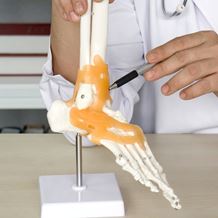Synovitis Ankle
- Home
- Services
- Orthopaedics
- Ankle Orthopaedics
- Common Ankle Conditions
- Synovitis Ankle
What is a Synovitis ankle?
Synovitis of the ankle is an inflammation of the soft tissue that lines the ankle joint. The soft tissue is responsible for keeping the joint lubricated to allow ease of movement. When this lining becomes inflamed, it causes painful symptoms such as swelling, redness, warmth and pain along the front and side of the ankle. The ankle joint can become stiff and tender to move or touch. Synovitis ankle can occur for many reasons such as injury, overuse or poor rehabilitation from a previous injury. If you have persistent ankle pain after suffering an initial injury, it is possible that synovitis ankle has developed. Weight-bearing too soon after an ankle sprain can also cause this condition. Synovitis of the ankle is also associated with degenerative diseases such as arthritis. Here, the lining starts to thicken and produce too much synovial fluid that eats away at the cartilage causing stiffness and pain.
How is it treated?
Once synovitis ankle is confirmed, the condition is treated conservatively at first using Rest, Ice, Compression and Elevation (RICE) as well as anti-inflammatory medication and pain relief. Ankle taping can help to reduce the strain on the surrounding muscles, and shoe orthotics can help with alignment. If symptoms persist, your doctor may suggest an ankle arthroscopy to investigate the inside of the ankle joint using a tiny camera. In chronic cases, your doctor may recommend a synovectomy. This procedure removes the inflamed synovial tissue that is causing the pain.
How long does it last?
If synovitis ankle is diagnosed and treated early, it can go away on its own within weeks. Most treatment methods are directed at the symptoms: decreasing inflammation, relieving pain and reducing swelling. Avoiding painful activities until you are symptom free will speed up the recovery process, before starting a gradual return to activities. Ignoring symptoms will lead to several months of recovery and a higher likelihood of a recurrence. In the event surgery is required, the recovery will be longer.
Find a hospital with orthopaedic services
Our Hospitals




